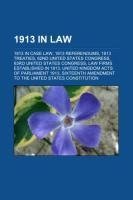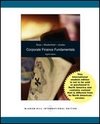
1913 in law
Source: Wikipedia. Pages: 38. Chapters: 1913 in case law, 1913 referendums, 1913 treaties, 62nd United States Congress, 63rd United States Congress, Law firms established in 1913, United Kingdom Acts of Parliament 1913, Sixteenth Amendment to the United... Viac o knihe
Produkt je dočasne nedostupný
15.14 €
bežná cena: 17.20 €
O knihe
Source: Wikipedia. Pages: 38. Chapters: 1913 in case law, 1913 referendums, 1913 treaties, 62nd United States Congress, 63rd United States Congress, Law firms established in 1913, United Kingdom Acts of Parliament 1913, Sixteenth Amendment to the United States Constitution, Seventeenth Amendment to the United States Constitution, Federal Trade Commission Act, Clayton Antitrust Act, Federal Reserve Act, United States Senate elections, 1910, Case of the Hooded Man, Lloyd - La Follette Act, Revenue Act of 1913, List of United States Senators in the 62nd Congress by seniority, Prisoners Act 1913, Steptoe & Johnson, Public Law 62-5, Webb-Kenyon Act, Massachusetts 1913 law, United States House of Representatives elections, 1912, Australian referendum, 1913, California Alien Land Law of 1913, Treaty of Athens, Natives' Land Act, Treaty of Constantinople, 1913 in organized crime, Heilbut, Symons & Co v Buckleton, Presidents pro tempore of the United States Senate, 1911-1913, Virus-Serum-Toxin Act, Railway Evaluation Act, Ancient Monuments Consolidation and Amendment Act 1913, Raker Act, Temperance Act 1913, Labor Department Act, Red Light Abatement Act, Newlands Labor Act, Urgent Deficiencies Act, Royal Bank of Canada v. The King, Weeks-McLean Act, Cunningham v. Cunningham, Sabath Act, Webb-Haney Act, Road and Trails Fund Act, Rivers and Harbors Act of 1913, Federal Revenue Sharing Act, Gould Amendment, Burnett Act, Kern Resolution, Publicity In Taking Evidence Act, Carlin Act, Burnt Timber Act. Excerpt: The Sixty-second United States Congress was a meeting of the legislative branch of the United States federal government, composed of the United States Senate and the United States House of Representatives. It met in Washington, DC from March 4, 1911 to March 4, 1913, during the third and fourth years of William H. Taft's presidency. The apportionment of seats in the House of Representatives was based on the Twelfth Census of the United States in 1900. Additional House seats were assigned to the two new states of New Mexico and Arizona. The size of the House was to be 435 starting with the new Congress coming into session in 1913. The Senate had a Republican majority, and the House had a Democratic majority. President of the SenateJames S. Sherman Map showing Senate party membership at the start of the 62nd Congress. Red states are represented by two Republicans and blue by two Democrats. Purple states are represented by one senator from each party. TOTAL members: 96 TOTAL members: 394 At this time, most Senators were elected by the state legislatures every two years, with one-third beginning new six year terms with each Congress. A few senators were elected directly by the residents of the state. Preceding the names in the list below are Senate class numbers, which indicate the cycle of their election. 2. William E. Borah (R) 1. Charles F. Johnson (D) 3. John W. Smith (D) 1. Luke Lea (D) The names of members of the House of Representatives are preceded by their district numbers. 7. William S. Goodwin (D) 10. Frank P. Woods (R)11. Elbert H. Hubbard (R), died June 4, 1912 3. Philip P. Campbell (R)4. Fred S. Jackson (R)5. Rollin R. Rees (R)6. Isaac D. Young (R)7. Edmond H. Madison (R), died September 18, 1911 8. Victor Murdock (R) 7. Arsène Paulin Pujó (D) 12. Leonidas C. Dyer (R)13. Walter Lewis Hensley (D)14. Joseph J. Russell (D)15. James Alexander Daugherty (D)16. Thomas L. Rubey (D) 4. Charles Henry Sloan (R)5. George W. Norr...
- Vydavateľstvo: Books LLC, Reference Series
- Formát: Paperback
- Jazyk:
- ISBN: 9781156108918



 Anglický jazyk
Anglický jazyk 







